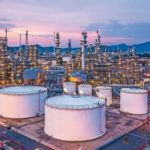In the oil & gas and petrochemical industries, the need for interface measurements arises whenever immiscible liquids reside within the same vessel. The lighter medium rises to the top while the heavier settles at the bottom. A layer is formed between the two fractions, which emulsify there to
a certain degree. This emulsion layer (also referred to as a “rag” layer) may form a narrow, distinct boundary, but more frequently it is a broader gradient of the mixed liquids. Generally, the thicker the emulsion layer, the greater the measurement challenge.
While monitoring the top, or total, level is critical for safety and overfill prevention, knowing the level of an interface is necessary to maintain product quality and operating efficiency. If water in oil is not separated effectively (water carry-over), this can lead to processing problems, equipment failures and unplanned shutdowns. On the other hand, if there is oil in water (oil extraction), there is a risk of lost production, environmental fines, penalties and forced shutdowns.
Choosing the right technology
For interface applications, there is no perfect technology that can be used everywhere. Of all the level switches and transmitters available, only a handful are suitable for reliable interface measurement. The leading interface measurement technologies include guided wave radar (GWR), buoyancy-based displacement and magnetostriction.
GWR is a popular choice because it can be used for both total level (potential overfill protection) and interface applications. Although GWR also has limitations for interface measurements, these are often mitigated by demulsifiers or increased process temperature to assist the separation of heavier oils.
Magnetostrictive technology is likewise employed for interface measurement. It is based on buoyancy principles, so that specific density related drawbacks exist, but it also has advantages particularly in applications with large or swelling emulsion layers. However, account must be taken of solids build-up, such as paraffin or asphaltene adhesion, due to the moving parts.
Horizontal separators
In the oil & gas and petrochemical industries, there are numerous interface applications that potentially produce an emulsion layer. For instance, when inlet crude oil from a well enters a separator, retention time may be the most important factor to achieve the desired instrumentation performance and, therefore, process optimisation. In other words, if the feed enters
a horizontal separator, the optimal installation position of the level measurement device is further away from the inlet (closer to the weir), where the separation of the crude oil and water becomes more uniform. Demulsifiers assist with emulsion breakdown but can be reduced when working in concert with reliable interface level measurement.
When device performance is maximised, tighter control of the top of the emulsion layer is possible. The top of the emulsion is an indicator of water present in oil. Since the primary goal of the separator is to remove water from the oil, level measurement allows operation closer to or further away from the weir, in order to optimise separator efficiency and retention time. If the separator is mainly intended for water storage, with a thin layer of oil on top, then tighter interface control will also provide
a more accurate representation of how much (pure) water is present in the vessel. This permits improved truck utilisation, ensuring full truckloads during water extraction from storage vessels.
This ideal installation may not always be possible with retrofits, but the instrumentation position is frequently taken into account by the separator design.
Separator boots
In refineries, boots are gravitational separation devices commonly found among, but not limited to, alkylation units, hydrotreaters, cokers and amine units. Extending off of the bottom of these horizontal vessels is a boot where an interface can occur between the process hydrocarbons and higher-density liquids such as residual water, HF acid, glycol or amine. The boot is a last-step separator to prevent particular liquids from reaching downstream processes. Ineffective boot interface measurements can have various consequences, from reduced productivity and process efficiency to catastrophic failures in downstream equipment.
If, for example, HF acid is knocked out through the boot, but the HF acid level is not controlled and it proceeds downstream, then it will corrode stainless steel piping, valves, fittings and instrumentation. In the other direction off of the boot, if hydrocarbon process liquids exit the boot with residual water, this will diminish the efficiency of the water treatment processes. Wastewater streams that have hydrocarbon particulates may cause downstream problems, such as plugging of screens or filters.
The Eclipse 706 GWR transmitter is an ideal solution for boots, often accompanied by
a magnetic level indicator (MLI) for visual indication. With the Aurora design from Orion Instruments, a Magnetrol company, users can benefit from the redundancy of
a GWR and MLI through a single external chamber. This can prove beneficial in tight spaces and smaller vessels such as boots, where users profit from two technologies utilising a single process connection (typically an existing set of mating flanges).
If the emulsion is too thick, a Jupiter JM4 magnetostrictive transmitter can be strapped onto the chamber externally.
Separating water and benzene
One of the largest polyolefin producers in Germany has a vessel with a mixture of benzene and water. Benzene, an aromatic hydrocarbon that is an important constituent of gasoline, has a very low dielectric (low conductivity) which can be problematic for certain technologies.
The level technology in this case was a GWR transmitter mounted in a chamber on the side of the vessel. The chamber had the potential to fill completely and there was
a tendency for the GWR to lose signal near the top of the probe due to the low Dk of the benzene.
Apart from a sight glass, the GWR was the only level technology in the vessel. The existing GWR signal was lost at different times of the day, including in the middle of the night, allowing zero remote visibility into the process and causing safety concerns due to potential overfill. Sometimes the signal was lost for hours and the only method of reacquiring it was to disconnect the power supply and restart.
During these times of lost signal, it was necessary to send a technician out to the vessel, no matter what the time of day or night, in order to physically inspect the sight glass.
This occurred many times over an 18-month span, as the GWR manufacturer was unable to resolve the issues related to the impedance mismatch, adding substantially to the total cost of ownership of the device.
Due to the failed GWR, this user considered switching to a displacer because of the technology’s historical reliability. However, it was decided to give GWR one last chance and install an Eclipse 706.
The 706 model, with its specifically designed impedance-matched probe, has performed flawlessly ever since. Impedance matching allows level measurement up past the process connection or 100 % level point, enabling overfill prevention or measurement in full chambers.
It has eliminated maintenance and service time at the vessel along with the inconvenience of lost signals. Supporting proof of reliability is provided by safety integrity level (SIL) documentation, such as certificates and FMEDA reports.
Outlook
GWR technology can provide acceptable solutions for many of the challenges that exist today. However, productivity still needs to be improved in applications with thicker, ever-changing emulsion layers. This includes desalters in refineries and even the applications highlighted above under certain conditions. The key to optimising interface measurements lies in solving the emulsion factor. No economical technology accomplishes all three level measurements: the top of the hydrocarbon level (total level) simultaneously with the top of the emulsion (water in oil) and the bottom of the emulsion (oil in water). For the level device, this is a multiphase (or three-phase) application.
Other technologies have attempted to provide a solution for multiphase measurement but have tended to be uneconomical. The aforementioned success with GWR, specifically for extremely challenging applications, could lead to future enhancements. GWR effectively measures interface due to the impedance changes that occur as the signal passes through the hydrocarbon level into the emulsion. However, as it does not take a great deal of water in a hydrocarbon to make it conductive, this results in an interface measurement near the top of the emulsion only, without detecting the bottom of the emulsion because there is no distinct impedance change through the layer.
Tackling this multiphase measurement is at the forefront of technology development since interface level is the most effective means of optimising separator processes and increasing uptime in the oil & gas and petrochemical industries.
Suchwort: cppPC119magnetrol
Hall 1, Booth R26











